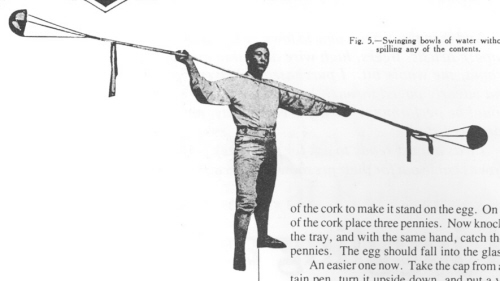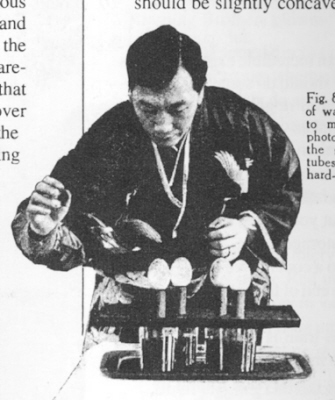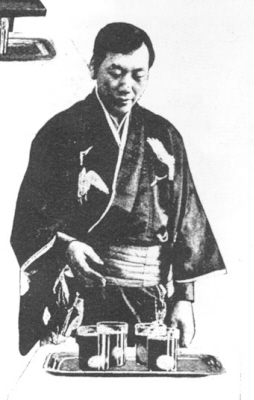One
of my favourite feats is that of swinging round two bowls of water
attached to the ends of a
long cord, without spilling a drop of the water (Fig.
5). It is difficult. Here is an easier one
which anyone
can try. It is really a feat of Japanese swordsmanship which anyone
can practise without a sword. Make two bands
of tissue paper, about a yard long and an inch wide. Get a
friend to hold two razors, one in each hand. Open the razors and hang
the bands of paper on the blades. Now take a stick and hang it on the
bands of paper. This must be done very carefully, or the papers will
be cut. Then pick up. a broomstick and with a mighty blow come down on
the centre of the stick. If you are successful you will break the
stick without breaking the bands of paper
(Fig. 6).
The
blow must be given quickly, and immediately before the blow is given
the broomstick should be brought up very rapidly so that the stick
resting on the papers is lifted slightly by the current of air caused
by the upward movement of the broomstick.
A
simpler and easier experiment is that of causing an egg to spin on a
tray by merely turning the tray with a circular motion. The egg
should be a blown one. Place it on the tray near the hand. Then cause
the egg to move round the tray
by slanting the tray in different directions.
When
the egg is well on the move, keep the tray level and turn it round and
round with a wide sweep of the arm. The motion will cause the egg to
spin quickly on
its side, and if the movement is kept up the egg will eventually spin
so fast on its side that it will raise itself and spin on its end. The
tray must then be held still and level.
Here
is a feat which requires a little practice (Figs. 8 and 9). Put some
water into four glasses and lay a tea tray over them. On the tray,
immediately over the glasses, stand four little cardboard tubes.
(These can easily be made by bending post cards into tubes and
fastening them with stamp-paper.) On the tubes place four eggs. It
will be advisable for the beginner to use hard-boiled eggs; small
apples will do equally well. Now open the hand, and with the
outstretched palm give the tray a sharp blow in such a way that the
cardboard tubes are knocked away and the eggs fall into the glasses of
water.
The
blow must not be "followed up"; the hand should remain
stationary when the tray has been knocked away. It must be a hard
blow, and it is as well to have someone to catch the tray.
For
the performance of the next simple feat, knowledge of a secret is
necessary. Remove the egg from one of the glasses used in the previous
feat. Take a strip of paper about an inch wide and six inches long and
hold it with one end on the edge of the glass. Now lay a penny - very
carefully - over the end of the strip of paper, so that the penny is
balanced on the edge of the glass over the paper. The feat consists in
removing the paper, using only one hand, without disturbing the
balance of the penny. The feat is quite simple if two hands are used,
because with one hand you can hold the free end of the paper while
with the other you give a sharp blow on the centre of the paper and so
draw it away from the glass. But only one hand is to be used. To do
this, take a knife or ruler and bring it down very quickly on the
paper; the feat cannot be done with certainty in any other way.
For
the accomplishment of our next feat, the amateur must have what is
known as a "straight eye." Place the crown of a bowler hat
on the top of a bottle, with the brim parallel to the neck of the
bottle and the crown resting on the bottle top. On the top side of the
crown, immediately over the mouth of the bottle, place a cork, and on
the cork lay a threepenny piece.
Pull
the hat away very quickly, and, if the buildingup has been done
properly, the cork will fall to the ground and the coin into the
bottle.
A
feat requiring a very steady hand can be performed with a glass
half-full of water. The feat consists in balancing the glass on its
edge on the table. The slightest movement of the floor of the room
renders the feat impossible, but it can be done after a very little
practice by anyone with a steady hand - or rather, two steady hands.
The
following is a more showy feat. Place a small tray over a tumbler
half-full of water. On the tray, immediately over the glass, place one
of the cardboard tubes used in a previous trick, and on the tube a
hard-boiled egg. One the egg balance a fork. It may be necessary to
scoop out the bottom of the cork to make it stand on the egg. On the
top of the cork place three pennies. Now knock away the tray, and with
the same hand, catch the three pennies. The egg should fall into the
glass.
An
easier one now. Take the cap from a fountain pen, turn it upside down,
and put a visiting card on the top. Put a penny on the car, and on the
penny a small nut. Now flick away the card with the thumb, so that the
penny, with the nut on it, is balanced on the cap. Then flick away the
penny so that the nut remains there.
Our
final feat shall be one I frequently do in public. I borrow a penny
from the audience and place it on the bottom of an inverted soda-water
glass. Holding the glass with both hands, I blow under the penny and
cause it to spin on the glass.
The
learner should note that my hands are held on either side of the glass
with the forefingers pointed upwards. Thus, I am able to get the glass
quite level. The feat is impossible if the glass is not level. To
begin with, I blow under the coin; when it has begun to spin I blow on
one side of it. It is not necessary to blow hard to make the coin
spin, and when the coin is spinning, properly its movement on the
glass is noiseless. The glass should be slightly concave.



